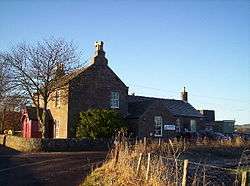Stracathro
| Stracathro | |
| Scottish Gaelic: Srath Catharach | |
 Stracathro School |
|
 Stracathro |
|
| OS grid reference | NO619648 |
|---|---|
| Council area | Angus |
| Lieutenancy area | Angus |
| Country | Scotland |
| Sovereign state | United Kingdom |
| Post town | BRECHIN |
| Postcode district | DD9 |
| Dialling code | 01356 |
| Police | Scottish |
| Fire | Scottish |
| Ambulance | Scottish |
| EU Parliament | Scotland |
| UK Parliament | Angus |
| Scottish Parliament | Angus North and Mearns |
Coordinates: 56°46′24″N 2°37′30″W / 56.773214°N 2.624998°W
Stracathro (Scottish Gaelic: Srath Catharach) is a small place in Angus, Scotland.
Location
Stracathro is located 2 1⁄2 miles (4.0 km) southeast of Edzell in NE Angus. It lies to the northeast of Brechin on the A90.[1]
History
A Roman marching camp has been discovered at Stracathro. This Roman Camp is one day's march from the next camp, at Raedykes to the north.[2] The gate design of the Stracathro Roman Camp is a distinctive bell-shaped indentation of the rampart perimeter.[3]
Stracathro was the site of the Battle of Stracathro in 1130. This was the culmination of an invasion into southern Scotland led by Angus, ruler of the partially independent "kingdom" of Moray, who desired to expand his territory and obtain recognition as a ruler independent of the Scottish kings. Angus was met by the royal army, led by the Constable of Scotland in the absence of King David, who had pressing business in England. The result was a decisive victory for the king's men. Four thousand Moravians were killed, including Angus, and Moray became wholly part of the kingdom of Scotland.[4]
At Stracathro on 7 July 1296, John Balliol publicly admitted the errors of his ways and confirmed his reconciliation with Edward I.
Stracathro House

Stracathro House is a fine A-listed Palladian-style mansion, overlooking the Cruick Water. In 1775, the Stracathro Estate, which extended to almost 800 hectares (2,000 acres), was bought by Patrick Cruickshank who had made his fortune in Jamaica.[5] His brother, Alexander inherited the property and employed the Aberdeen-based architect Archibald Simpson (1790–1847) to build the house between 1824–27, together with a deer-park and gardens. In 1874, the house and estate was purchased by Sir James Campbell (1790–1876), Lord Provost of Glasgow and father of Prime Minister Sir Henry Campbell-Bannerman (1836–1908).[5]
Stracathro House reverted to private ownership following its sale by Tayside Health Board in 2003. It is being refurbished as a family home.[5] Cottages in the grounds are let as self-catering holiday accommodation.[6]
Stracathro Hospital
Stracathro House was leased by the government in 1938 and a temporary Emergency Medical Services Hospital built in the grounds to cope with military and civilian casualties of World War II.[5] The house was used as a residence for doctors and nurses and was later purchased by the local health authority. Stracathro Hospital became a District General Hospital and is now part of NHS Tayside Stracathro House and policies, have been in private ownership since 2003.
Footnotes
- ↑ "Stonehaven and Banchory", Ordnance Survey Landranger Map (C1 ed.), 2009, ISBN 0-319-23168-2
- ↑ C. Michael Hogan (3 October 2007). Andy Burnham, ed. "Raedykes Roman Camp". The Megalithic Portal. Retrieved 2009-08-29.
- ↑ "Stracathro Roman Camp". Roman Britain. 2005. Retrieved 2009-08-29.
- ↑ Paul, Sir James (1909). The Scots Peerage. Edinburgh: David Douglas.
- 1 2 3 4 "Stracathro House". Gazetteer for Scotland. Retrieved 2009-08-29.
- ↑ "Stracathro Holiday Cottages". franclyn ltd. Retrieved 2010-01-31.
| Wikimedia Commons has media related to Stracathro. |